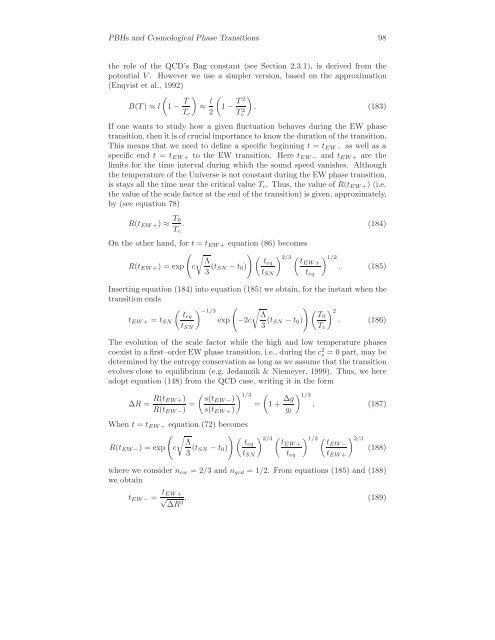Primordial Black Holes and Cosmological Phase Transitions Report ...
Primordial Black Holes and Cosmological Phase Transitions Report ...
Primordial Black Holes and Cosmological Phase Transitions Report ...
Create successful ePaper yourself
Turn your PDF publications into a flip-book with our unique Google optimized e-Paper software.
PBHs <strong>and</strong> <strong>Cosmological</strong> <strong>Phase</strong> <strong>Transitions</strong> 98<br />
the role of the QCD’s Bag constant (see Section 2.3.1), is derived from the<br />
potential V . However we use a simpler version, based on the approximation<br />
(Enqvist et al., 1992)<br />
B(T ) ≈ l<br />
<br />
1 − T<br />
Tc<br />
<br />
≈ l<br />
<br />
1 −<br />
2<br />
T 2<br />
T 2 c<br />
<br />
. (183)<br />
If one wants to study how a given fluctuation behaves during the EW phase<br />
transition, then it is of crucial importance to know the duration of the transition.<br />
This means that we need to define a specific beginning t = tEW− as well as a<br />
specific end t = tEW+ to the EW transition. Here tEW− <strong>and</strong> tEW+ are the<br />
limits for the time interval during which the sound speed vanishes. Although<br />
the temperature of the Universe is not constant during the EW phase transition,<br />
is stays all the time near the critical value Tc. Thus, the value of R(tEW+) (i.e.<br />
the value of the scale factor at the end of the transition) is given, approximately,<br />
by (see equation 78)<br />
R(tEW+) ≈ T0<br />
Tc<br />
. (184)<br />
On the other h<strong>and</strong>, for t = tEW+ equation (86) becomes<br />
<br />
Λ<br />
R(tEW+) = exp c<br />
3 (tSN<br />
<br />
teq<br />
− t0)<br />
2/3 1/2 tEW+<br />
. (185)<br />
Inserting equation (184) into equation (185) we obtain, for the instant when the<br />
transition ends<br />
<br />
teq<br />
tEW+ = tSN<br />
−1/3<br />
Λ<br />
exp −2c<br />
3 (tSN<br />
T0 2 − t0) . (186)<br />
tSN<br />
The evolution of the scale factor while the high <strong>and</strong> low temperature phases<br />
coexist in a first–order EW phase transition, i.e., during the c2 s = 0 part, may be<br />
determined by the entropy conservation as long as we assume that the transition<br />
evolves close to equilibrium (e.g. Jedamzik & Niemeyer, 1999). Thus, we here<br />
adopt equation (148) from the QCD case, writing it in the form<br />
∆R = R(tEW+)<br />
R(tEW−) =<br />
1/3 <br />
s(tEW−)<br />
= 1+<br />
s(tEW+)<br />
∆g<br />
1/3 . (187)<br />
tSN<br />
When t = tEW− equation (72) becomes<br />
<br />
Λ<br />
R(tEW−) = exp c<br />
3 (tSN<br />
2/3 1/2 <br />
teq tEW+ tEW−<br />
− t0)<br />
tSN<br />
gl<br />
teq<br />
teq<br />
Tc<br />
tEW+<br />
2/3<br />
(188)<br />
where we consider new =2/3 <strong>and</strong> nqcd =1/2. From equations (185) <strong>and</strong> (188)<br />
we obtain<br />
tEW− = tEW+<br />
√ . (189)<br />
∆R3
















